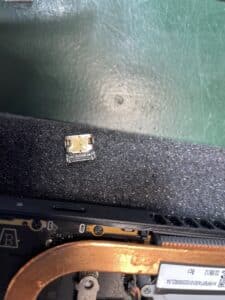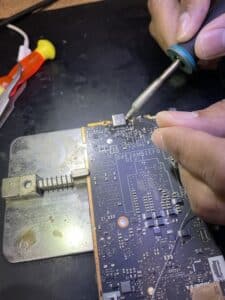We received a Steam Deck with power issues. Luckily for this customer, it was a simple fix. The charging USC-c port was damaged preventing proper charging of the device.
Charging ports on devices like the Steam Deck can get damaged due to various reasons, including:
- Physical damage: Accidental drops or impacts can cause the charging port to get damaged. If the port gets bent or pushed in, it may not be able to make proper contact with the charging cable.
- Overuse or rough handling: Constant plugging and unplugging of the charging cable can wear out the port over time, especially if it’s done forcefully or at an angle.
- Poor quality cables: Using low-quality or incompatible charging cables can put undue stress on the charging port, leading to damage.
Replacing the charging port on Steam Deck is not a very complicated but it is a time consuming process. The device needs to be taken apart, board removed, old port replaced, new port soldered on.
View of the new USB Port; View of the port replacement process;


The Steam Deck is a handheld gaming device developed and released by Valve Corporation. It was announced in July 2021 and began shipping to customers in February 2022. The device is designed to offer PC gaming on the go, leveraging Valve’s Steam platform, which is a leading digital distribution service for video games. The Steam Deck runs on a custom AMD APU for high-performance gaming in a portable form factor, featuring a Zen 2 CPU and RDNA 2 GPU architecture.
One of the key features of the Steam Deck is its ability to run a wide range of PC games from the Steam library, including AAA titles, indie games, and everything in between. It operates on SteamOS 3.0, a Linux-based operating system specifically optimized for the Steam Deck, but users also have the option to install Windows or other operating systems to expand its functionality and game compatibility.
The device sports a 7-inch touchscreen display with a resolution of 1280×800 pixels, offering a 16:10 aspect ratio. It also includes traditional game controls, such as thumbsticks, a D-pad, action buttons, and trackpads, to support a variety of gameplay experiences. Additionally, it features gyroscopic controls for more precision in certain games.
The Steam Deck is available in several storage configurations, including models with 64GB eMMC, 256GB NVMe SSD, and 512GB NVMe SSD, catering to different performance needs and budgets. It also supports microSD cards for further storage expansion.
Valve’s Steam Deck has been praised for its versatility, allowing gamers to take their PC game library on the go, access a wide range of software through the Linux desktop mode, and even use it as a portable PC by connecting it to external displays, keyboards, and mice. Its performance varies by game, with some titles needing to be optimized for the handheld experience, but it has generally been well-received for delivering PC gaming in a portable and flexible format.
